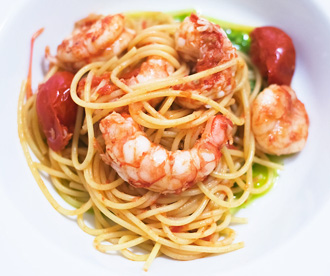Table of Contents
Buying
Choose a live European lobster from a reputable seafood market to ensure the highest quality and freshness. European blue lobster is characterized by its striking blue hue. The color may vary, but a healthy blue lobster should have a noticeable blue tint.
Examine the lobster for any signs of dirt, debris, or abnormal growths on its shell. A clean and well-maintained appearance is indicative of a healthy lobster.
Avoid those with a strong, unpleasant odor, as this may indicate deterioration or spoilage.
Storing
European blue lobsters, like other lobsters, should be kept alive until you are ready to cook them. Lobsters are perishable, and keeping them alive ensures freshness. So, keep them in cold, saline water in a tank. Avoid overcrowding if you have bought too many lobsters.
Preparation
Remember, handling large and live lobsters requires caution. They have sharp claws and can pinch, so handle them carefully.
To prepare, fill a large pot with enough water to cover the lobster completely. Add salt to the water; about 2 tablespoons per gallon is a common ratio. Bring the water to a rolling boil.
Quickly and carefully place the live lobster headfirst into the boiling water. You can also use a long pair of tongs to lower it in slowly.
Boil it for about 8-12 minutes per pound. For example, if your lobster weighs 2 pounds, you would boil it for 16-24 minutes. The shell should turn bright red, and the meat should be opaque.
Use lobster crackers and picks to crack open the shell and extract the meat. Don’t forget the meat from the claws and legs. Gently twisting off the legs and claws to separate meat.
The yield of lobster meat is approximately 30-35%.
Here are some serving ideas:
European blue lobster is a delicious and versatile ingredient that can be used in various recipes, from soups and luxurious and decadent main dishes like lobster lasagna.
Due to their rarity and unique coloration, there is a demand for blue lobsters in the culinary and seafood markets, particularly among consumers looking for exclusive and high-end dining experiences.
European lobster has sweet, briny and tender body meat and slightly firmer claw meat.
-
Enjoy blue lobster with garlic butter sauce, season with salt and pepper to taste. Sprinkle chopped fresh parsley over the lobster. Serve with lemon wedges on the side for squeezing over the lobster.
-
Prepare French-style smooth, creamy, lobster bisque with melt butter and sauté onion, carrots, celery, and garlic. Serve hot, garnished with fresh parsley.
-
Grill lobster tails with olive oil and sprinkle with garlic powder, paprika, salt, and pepper. Serve with lemon wedges.
-
Prepare European lobster pasta with creamy Alfredo Sauce. Add Parmesan cheese and stir until the sauce is smooth. Season with salt and pepper, and garnish with fresh parsley before serving.
Safety profile
Some individuals may be allergic to shellfish, including European lobsters. Allergic reactions can range from mild to severe, so individuals with shellfish allergies should avoid consuming lobster.
To maintain safety, ensure that lobsters are stored and handled properly to prevent foodborne illnesses associated with lobster consumption. Cooking lobster thoroughly is crucial to kill potential harmful bacteria.
Lobsters are generally low in mercury compared to some other seafood like albacore tuna, composing just 0.107 Parts Per Million (PPM). According to the U.S. FDA guidelines for expectant and breastfeeding mothers, blue lobster falls into the “best choice” category, allowing for 2-3 servings per week. (Medical disclaimer).
Also read ≻≻-
≺≺ Lobster nutrition facts and health benefits.
≺≺ Blue Crab nutrition facts and health benefits.
≺≺ Shrimp nutrition facts and health advantages.
≺≺ Sea Scallops nutrition facts and health benefits.
≺≺ Back to Seafood from European Lobster nutrition facts and health advantages.
Further reading (Links opens in new window):
-
European lobster- INSTITUTE OF MARINE RESEARCH.
-
European lobster- Homarus gammarus .
-
Omega-3 Fatty Acids: An Essential Contribution.
-
European Commission: Species- Homarus gammarus.





More Stories
United Healthcare’s ransomware attack shows why supply chains are under siege
Nutrition Tips For Ramadan | JM Nutrition
Probiotics for IBS | The Nutritionist Reviews